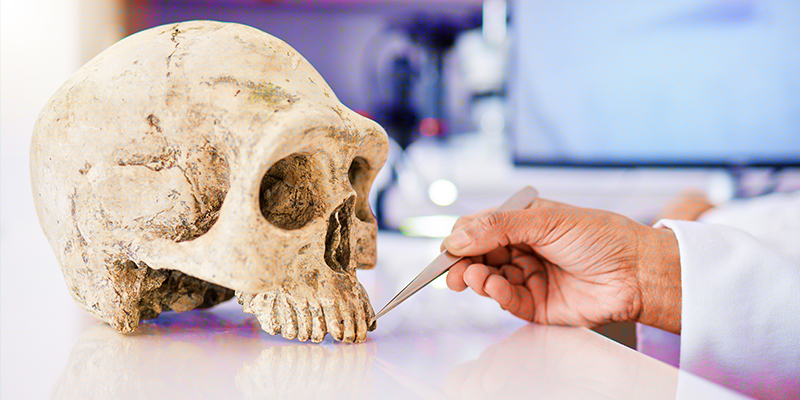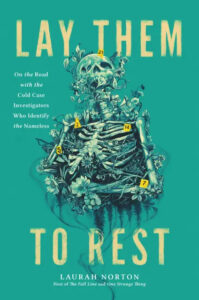The risk of becoming an unidentified decedent, or a John or Jane Doe, isn’t something most of us will face when we die—but it is a possibility, especially for the most vulnerable among us. There are tens of thousands of long-term unidentified persons in the United States, whose cases have sat for years, even decades, without resolution. In life, we can prove who we are in any number of ways. There are webs of connecting threads. But in death? Those identifiers fade, or snap. They can be forcibly removed, or they’re stolen by time, or environment, or chance.
Some of those victims were discovered only minutes after death and yet still cannot not be identified. I’ve seen cases where the lack of a driver’s license or other ID was enough to stall a case—even when the victim was a local, and a drawing of their face ran in the paper. And when the situation provides fewer clues—say, a single femur washed up on shore in Maine, or a cranium recovered in the desert of New Mexico? Tracing a single element back to its source can feel like an impossible task.
But we know that isn’t true. The headlines tell us so: John and Jane Doe cases are solved with ever-increasing frequency, largely thanks to the advent of forensic investigative genetic genealogy (FIGG), a discipline that’s been known by a number of names in its brief time on the forensic scene.
When the Golden State Killer, Joseph DeAngelo, was arrested back in 2018, a world of possibility opened up. To the general public, anyway—the field’s pioneers had been working behind the scenes for quite some time. They’d identified Doe victims before DeAngelo’s face ever flashed across our newsfeeds.
In the rush of excitement, it felt like every cold case might be solved. But of course, that’s not so simple: for any case to be solved via any kind of DNA test, you need material that can produce a usable profile. And many of the coldest cases can’t provide that.
In an unidentified-persons case, human remains and other biological material are the evidence: bone, teeth, blood samples, even rootless hair. But the reality is, some cases don’t have those elements, or for some reason, they aren’t in a testable state. Perhaps cremation has destroyed remains beyond testing, or they have been chemically treated in a manner that degrades DNA.
Or. . . maybe the victims’ remains have been lost. This happens: a burial ground’s records are misplaced, or the grave markers shift or are even removed. An evidence room floods. There’s a fire. Paperwork falls through the cracks. No one knows where the bones are stored. What then?
How do you solve a case when, for one reason or another, DNA testing is not possible?
There are quite a few options. All those cases we see in the headlines? There are others that never make it there, because they are solved in days, weeks, or months, through the work of a variety of forensic experts including medical examiners, anthropologists, odontologists, and the like. These professionals close cases through various methods of comparison—including bone and teeth. It’s what they did before any DNA testing was possible, and it’s still very regular practice.
I’m always most interested in what people can do when they have the least access, the fewest options.I’m always most interested in what people can do when they have the least access, the fewest options. So, let’s say we are looking at a case where there are no remains available at all—what do we do then? Well, if there’s a file, or anything uploaded to the databases, like dental charts—there’s hope. Because those details can be pulled together, and they can add up to a match. The footprints of paperwork we leave behind us, in our lives, may reconnect a broken thread.
Even without remains, the experts can still offer their opinions, though perhaps in limited scope, if they’re given enough information. If there are photos, charts, and details, they can provide assessment and update you on older reports with newer scientific knowledge. They’ll also be able to make or verify a match, once a candidate is found, provided the missing person’s records also hold enough information.
About that searching. . . where to start? You’ve probably already thought of fingerprints—and that’s smart. If fingerprints were possible to take, and those records were retained for a Doe victim’s file, they can be used to make a positive ID. The methods for running fingerprints have vastly improved, and old records are digitized every day by government agencies and law enforcement. It doesn’t matter why it was taken–an arrest, a job, or some other situation requiring clearance. It’s why detectives re-run prints that didn’t have a “hit” every so often; there’s always a chance for a new match.
And teeth are as unique as fingerprints, in their way, and likely more thoroughly documented. Though dental care is not universally accessible in the United States, many people do have a fairly complete dental history, and that comes with charting of the changes a person’s teeth have undergone: every filling, crown, cavity, and each extracted wisdom tooth.
There is no national database of dental records, but if investigators are thorough, the existing records of missing people will be uploaded to The National Missing and Unidentified Persons System (NamUs), and any expert with access can compare those records to the information retained in the file of an unidentified person. A dental X Ray can easily be checked against the notations made in a John or Jane Doe’s file. Dental charting is done for unidentified persons to note the same things a dentist would: crowns, cavities, fillings.
Experts can also be tapped to reach the public and enlist our help, through forensic art. If there’s a clear photo of remains that feature enough remnants of facial structure, an artist may be able to produce a reconstruction. Combined with the notes from an anthropologist or medicolegal professional, a skillful forensic approximation could be key. Artists hope they can capture likeness enough so that someone will recognize it.
And having art is incredibly useful. Humans like having something to look at, and we like to see other people. A face makes us stop, and read, and share. An article about a Doe victim that features a rendering of a face will reach a wider audience, on social media, in newspapers, everywhere. And that may bring in tips, which is incredibly helpful. Because the work of narrowing down individuals to compare against a decedent can be a monumental task.
It’s not helped by the fact that many missing persons go unreported: it’s no small task to target likely candidates so that comparisons can be made. But the identifying details that medicolegal professionals jot down in a Doe decedent’s file can help with that too.
Think about the clues our medical records hold, and how they might be used in a kind of reverse engineering. After all, implants, devices, and medical procedures tell their own stories. There are surgical scars and removals, of course. But even methods matter. Techniques and tools fall in and out of use. Materials change. Serial numbers come into use, and then are tracked. The make or model of a screw or a clamp can supply clues to decade of production, manufacturer, or even lead to a practice or hospital. All that information can narrow down time and place.
Maybe the right person won’t pop up in a NamUs search. But perhaps a family remember will recognize the description of a scar, or medical device, or fractured bone or steel rod. Maybe the news archives contain an article that covered an auto accident and described a specific injury. It’s even possible a disappearance made its way to the local papers, but never into the official databases, and will include just the right detail.
Other seemingly minor descriptive notations can help, too. I’ve seen detectives trace a decedent’s clothing and shoes to the stores that sold them, and narrow down when they were purchased to a few months or weeks’ time. In one case, an astrology charm identified a Jane Doe’s month of birth. If an item is unique, it could even lead to a custom order, or a family heirloom that shows up scanned photos posted to social media.
DNA is certainly our biggest and brightest tool in this fight to reconnect decedents with their identities. But it’s not the only one, and even when we’re left with very little—the chance of resolution remains, and the longest-shot case still has a shot. All fields of science advance, and so does our access to information: to archived newspapers, to law-enforcement databases, to each other. The world is searchable. Not every missing person is listed in a database. Far from it. But that doesn’t mean they lived and died without a trace. And we’re better equipped now, than ever, to find, and then to follow those broken threads to the answer.
***


















